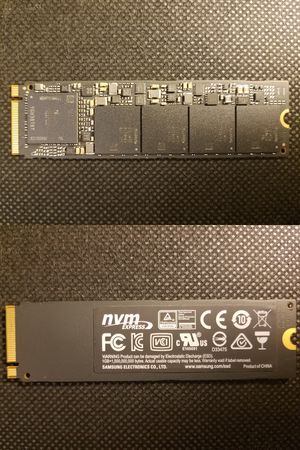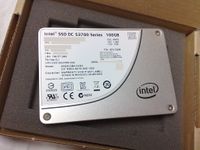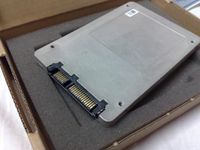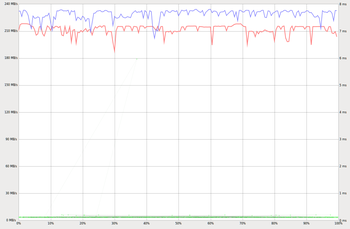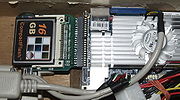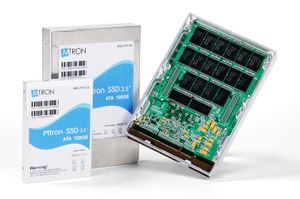محرك أقراص الحالة الصلبة
 محرك أقراص الحالة الصلبة من إنتاج سوپر تالنت تكنولوجي 2.5. | |
| تاريخ الاختراع | 1978 |
|---|---|
| المخترع | شركة ستوردج تكنولوجي |
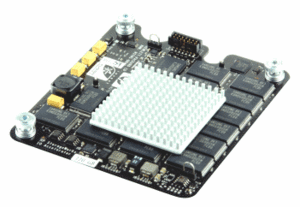
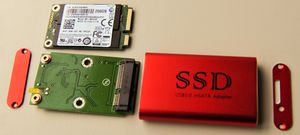
محرك أقراص الحالة الصلبة أو القرص الإلكتروني solid-state drive (SSD)، هو جهاز تخزين الحالة الصلبة يستخدم تجميعات الدوائر المتكاملة كذاكرة لتخزين البيانات بشكل متزامن. كما يسمى أحياناً قرص الحالة الصلبة solid-state disk،[1] كلمة "قرص" غير مناسبة حيث أن محركات أقراص الحالة الصلبة ليست أقراص بالمعنى المادي. تستخدم محركات أقراص الحالة الصلبة واجهات محرك القرص الصلب، مثل ساتا وساس، التي تبسط بشكل كبير استخدام محركات أقراص الحالة الصلبة في الحاسوب.[2] في أعقاب القبول المبدئي باستخدام محركات أقراص الحالة الصلبة مع واجهات محركات القرص الصلب، تم تصميم الواجهات الجديدة مثل إم.2 ويو.2 لتلبية بعض المتطلبات لتكنولوجيا ذاكرة الفلاش المستخدمة في محركات الأقراص الصلبة.
لا تتضمن محركات الأقراص الصلبة مكونات ميكانيكية متحركة. يميزها هذا عن محركات الأقراص الكهروميكانيكية التقليدية مثل محركات الأقراص الصلبة أو الأقراص المرنة، والتي تحتوي على أقراص دورانية وread/write heads متحركة.[3] مقارنة بمحركات الأقراص الكهروميكانيكية، فمحركات أقراص الحالة الصلبة أكثر مقاومة للصدمات المادية، تعمل في صمت، تتمتع بزمن ولوج أسرع وكمون أقل.[4] ومع ذلك، فبينما يستمر سعر محركات أقراص الحالة الصلبة في الانخفاض بمرور الوقت، فلا يزال هناك محركات أقراص الحالة الصالبة الأغلى ثمناً لكل وحدة تخزين مقارنة بمحركات الأقراص الصلبة ومن المتوقع أن تستمر في الارتفاع في العقد القادم.
منذ 2017، معظم محركات الأقراص الصلبة تستخدم 3D TLC NAND-based flash memory، وهي أحد أنواع الذاكرات المستديمة التي تحتفظ بالبيانات عند انقطاع الطاقة. من أجل التطبيقات التي تتطلب سرعة ولوج لكنها لا تحتاج لتزامن البيانات بعد انقطاع الطاقة، يمكن إنشاء محركات أقراص الحالة الصلبة من ذاكرة الولوج العشوائي. قد تستخدم مثل هذه الأجهزة البطاريات كمصدر مدمج للطاقة من أجل الاحتفاظ بالبيانات لفترة زمنية معينة بعد إنقطاع الطاقة الخارجية.[2]
إلا أن جميع محركات أقراص الحالة الصلبة لا زالت تخزن البيانات في الشحنات الكهربائية، والتي تتسرب ببطئ مع الوقت إذا تركت بدون مصدر للطاقة. قد يتسبب هذا في تلف محركات الأقراص (التي تجاوزت تصنيف التحمل) لبدء فقدان البيانات والذي عادة ما يحدث بعد عام (إذا تم التخزين في درجة حرارة 30 °س) أو عامين (عند 25 °س)، وفي حالة محركات الأقراص الجديدة يتطلب وقتاً أطول.[5] وبالتالي فمحركات أقراص الحالة الصلبة غير ملائمة للأغراض الأرشيفية.
محركات الأقراص الهجينة أو محركات أقراص الحالة الصلبة الهجينة، مثل درايڤ فوجن من أپل، يجمع بين مميزات محركات أقراص الحالة الصلبة ومحركات الأقراص الصلبة في نفس الوحدة، والتي تحتوي على محرك أقراص صلبة ضخم ومحرك أقراص الحالة الصلبة من أجل تحسين أداء البيانات التي يتم الوصول إليها بشكل متكرر.[6][7][8]
التطوير والتاريخ
العمارة والوظيفة
المكونات:
- الذاكرة المخبئة إنگليزية: cache: محركات أقراص الحالة الصلبة تستعمل ذواكر وصول عشوائي ديناميكية كثيرة وبأحجام صغيرة كذاكرة مخبئيه، وهي شبيهة بالذاكرة المخبئية في الأقراص الصلبة.
- مخزن للطاقة: نوع من أنواع البطاريات، وهي ضرورية لحفظ المعلومات من الضياع في حال الانقطاع المفاجئ للتيار.
الذاكرة
ذاكرة الفلاش
| مقارنة الخصائص | MLC : SLC | NAND : NOR |
|---|---|---|
| Persistence ratio | 1 : 10 | 1 : 10 |
| Sequential write ratio | 1 : 3 | 1 : 4 |
| Sequential read ratio | 1 : 1 | 1 : 5 |
| Price ratio | 1 : 1.3 | 1 : 0.7 |
محركات الأقراص المبنية على تقنية ذاكرة الفلاش أو محركات الأقراص الصلبة الجامدة الفلاش
أغلب مصنعي محركات الأقراص الصلبة يستخدمون تقنية ذاكرة الفلاش لصناعة محركات أقراص قوية وقابلة لتحمل الصدمات. محركات الأقراص الصلبة الفلاش لا تحتاج إلى بطاريات من أجل حفظ المعلومات، وتكون بأحجام مختلفة 3.5 و2.5 و1.8 بوصة. محركات الأقراص الصلبة الفلاش تحتفظ بالمعلومات حتى لو حصل انقطاع مفاجئ للتيار الكهربائي. وهي أبطء من ذاكرة الوصول العشوائي والقرص الصلب، ولكن قد تكون ذو أداء أفضل من الأقراص الصلبة، لأنه تم إزالة وقت البحث الذي ينتج عنه تحرك القرص وتحرك رأس القراءة والكتابة في القرص الصلب لعدم وجود أجزاء متحركة في الذاكرة.
محركات الأقراص الهجينة
الواجهة المضيفة
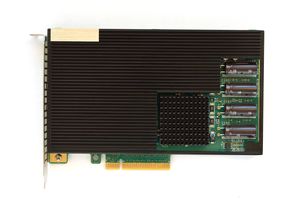
التكوينات
المقارنة بالتقنيات الأخرى
الميزات
- إقلاع النظام أسرع لعدم وجود أجزاء متحركة في محركات أقراص الحالة الصلبة.
- أسرع في الوصول العشوائي للقراءة حيث لا يوجد رأس قراءة أو كتابة.
- لا تصدر صوت لعدم وجود الأجزاء المتحركة أو عدم وجود مراوح تبريد في محركات الأقرارص صغيرة السعة (يوجد مراوح في محركات الأقراص ذات السعة العالية).
- تستخدم تيار كهربائي أقل من القرص الصلب.
- مستويات تحمل أعلى لدرجات الحرارة فالقرص الصلب يعمل ما بين 5-55 درجة مئوية أما محركات أقراص الحالة الصلبة فتصل مستوى تحملها إلى 70 درجة مئوية، وبعضها يصل إلى مستويات أعلى من ذلك.
العيوب
- السعر: في منتصف 2013 كان سعر الجيجابايت لمحركات أقراص الحالة الصلبة أعلى إلى حد كبير من الجيجابايت للقرص الصلب: فكان الجيجابايت سعرة ما بين 1.00-30.45 $ دولار أمريكي للجيجابايت لمحركات أقراص الحالة الصلبة أما القرص الصلب سعر الجيجابايت تقريباً 0.038 $ دولار أمريكي.
- المساحة: متوسط مساحة القرص الصلب أكبر بكثير من مساحة محركات أقراص الحالة الصلبة، حيث مساحة الأقراص الصلبة من الممكن أن تصل إلى 2 تيرابايت (2014)، أما محركات أقراص الحالة الصلبة فحوالي 120 جيجابايت إلى 1 تيرابايت (2014) .
- عمر محركات أقراص الحالة الصلبة (SSD) مرتبط بعدد مرات عمليات الكتابة، فسواقة الحالة الصلبة محدودة في عمليات الكتابة مثل "فلاشة USB" ، لهذا القرص الصلب ممكن يعمل لمدة أكبر لأن عمليات الكتابة لا تؤثر فيه، لكن حدود مرات الكتابة ليس بعدد صغير.
محركات الأقراص الصلبة
| Attribute or characteristic | محرك أقراص الحالة الصلبة | محرك الأقراص الصلبة |
|---|---|---|
| Reliability on storage retention | If left without power, worn out SSDs typically start to lose data after about one to two years in storage, depending on temperature. New drives are supposed to retain data for about ten years.[5] MLC and TLC based devices tend to lose data earlier than SLC-based devices. SSDs are not suited for archival use. | If kept in a dry environment at low temperature, HDDs can retain their data for a very long period of time even without power. However, the mechanical parts tend to become clotted over time and the drive fails to spin up after a few years in storage. |
| Start-up time | Almost instantaneous; no mechanical components to prepare. May need a few milliseconds to come out of an automatic power-saving mode. | Drive spin-up may take several seconds. A system with many drives may need to stagger spin-up to limit peak power drawn, which is briefly high when an HDD is first started.[11] |
| Sequential access performance | In consumer products the maximum transfer rate typically ranges from about 200 MB/s to 2500 MB/s, depending on the drive. Enterprise market offers devices with multi-gigabyte per second throughput. | Once the head is positioned, when reading or writing a continuous track, a modern HDD can transfer data at about 200 MB/s. Data transfer rate depends also upon rotational speed, which can range from 3,600 to 15,000 rpm[12] and also upon the track (reading from the outer tracks is faster). |
| Random access performance[13] | Random access time typically under 0.1 ms.[14][15] As data can be retrieved directly from various locations of the flash memory, access time is usually not a big performance bottleneck. Read performance does not change based on where data is stored. In applications where hard disk drive seeks are the limiting factor, this results in faster boot and application launch times (see Amdahl's law).[16][11]
SSD technology can deliver rather consistent read/write speed, but when lots of individual smaller blocks are accessed, performance is reduced. SSDs suffer from a write performance degradation phenomenon called write amplification, where the NAND cells show a measurable drop in performance, and will continue degrading throughout the life of the SSD.[17] A technique called wear leveling is implemented to mitigate this effect, but due to the nature of the NAND chips, the drive will inevitably degrade at a noticeable rate.[التحقق مطلوب] |
Read latency time is much higher than SSDs.[18] Random access time ranges from 2.9 (high end server drive) to 12 ms (laptop HDD) due to the need to move the heads and wait for the data to rotate under the magnetic head.[19] Read time is different for every different seek, since the location of the data and the location of the head are likely different. If data from different areas of the platter must be accessed, as with fragmented files, response times will be increased by the need to seek each fragment.[20] |
| Impacts of file system fragmentation | There is limited benefit to reading data sequentially (beyond typical FS block sizes, say 4 KB), making fragmentation negligible for SSDs. Defragmentation would cause wear by making additional writes of the NAND flash cells, which have a limited cycle life.[21][22] However, even on SSDs there is a practical limit on how much fragmentation certain file systems can sustain; once that limit is reached, subsequent file allocations fail.[23] Consequently, defragmentation may still be necessary, although to a lesser degree.[23] | Some file systems, like NTFS, become fragmented over time if frequently written; periodic defragmentation is required to maintain optimum performance.[24] This usually is not an issue in modern file systems. |
| Noise (acoustic)[25] | SSDs have no moving parts and therefore are basically silent, although on some SSDs, high pitch noise from the high voltage generator (for erasing blocks) may occur. | HDDs have moving parts (heads, actuator, and spindle motor) and make characteristic sounds of whirring and clicking; noise levels vary between models, but can be significant (while often much lower than the sound from the cooling fans). Laptop hard drives are relatively quiet. |
| Temperature control[26] | A study conducted by Facebook found a consistent failure rate at temperatures between 30 and 40 °C. Failure rate rises when operating at temperatures higher than 40 °C, further increase of temperature may trigger thermal throttling around 70 °C, resulting reduced runtime performance. Reliability of early SSDs without thermal throttling are more affected by temperature, than newer ones with thermal throttling.[27] In practice, SSDs usually do not require any special cooling and can tolerate higher temperatures than HDDs. High-end enterprise models installed as add-on cards or 2.5-inch bay devices may ship with heat sinks to dissipate generated heat, requiring certain volumes of airflow to operate.[28] | Ambient temperatures above 35 °C (95 °F) can shorten the life of a hard disk, and reliability will be compromised at drive temperatures above 55 °C (131 °F). Fan cooling may be required if temperatures would otherwise exceed these values.[29] In practice, modern HDDs may be used with no special arrangements for cooling. |
| Lowest operating temperature[30] | SSDs can operate at −55 °C (−67 °F). | Most modern HDDs can operate at 0 °C (32 °F). |
| Highest altitude when operating[31] | SSDs have no issues on this.[32] | HDDs can operate safely at an altitude of at most 3,000 meters (10,000 ft). HDDs will fail to operate at altitudes above 12,000 meters (40,000 ft).[33] With the introduction of helium-filled[بحاجة لمصدر] (sealed) HDDs, this is expected to be less of an issue. |
| Moving from a cold environment to a warmer environment | SSDs have no issues on this.[بحاجة لمصدر] | A certain amount of acclimation time is needed when moving HDDs from a cold environment to a warmer environment prior to operating it; otherwise, internal condensation will occur and operating it immediately will result in damage to its internal components.[34] |
| Breather hole | SSDs do not require a breather hole. | Most modern HDDs require a breather hole in order for it to function properly.[33] Helium-filled devices do not have a hole. |
| Susceptibility to environmental factors[16][35][36] | No moving parts, very resistant to shock, vibration, and movement. | Heads floating above rapidly rotating platters are susceptible to shock, vibration, and movement. |
| Installation and mounting | Not sensitive to orientation, vibration, or shock. Usually no exposed circuitry. Circuitry may be exposed in a card form device and it must not be short-circuited by conductive materials. | Circuitry may be exposed, and it must not be short-circuited by conductive materials (such as the metal chassis of a computer). Should be mounted to protect against vibration and shock. Some HDDs should not be installed in a tilted position.[37] |
| Susceptibility to magnetic fields | Low impact on flash memory, but an electromagnetic pulse will damage any electrical system, especially integrated circuits. | In general, magnets or magnetic surges may result in data corruption or mechanical damage to the drive internals. Drive's metal case provides a low level of shielding to the magnetic platters.[38][39][40] |
| Weight and size[35] | SSDs, essentially semiconductor memory devices mounted on a circuit board, are small and lightweight. They often follow the same form factors as HDDs (2.5-inch or 1.8-inch), but the enclosures are made mostly of plastic. | HDDs are generally heavier than SSDs, as the enclosures are made mostly of metal, and they contain heavy objects such as motors and large magnets. 3.5-inch drives typically weigh around 700 grams. |
| Reliability and lifetime | SSDs have no moving parts to fail mechanically. Each block of a flash-based SSD can only be erased (and therefore written) a limited number of times before it fails. The controllers manage this limitation so that drives can last for many years under normal use.[41][42][43][44][45] SSDs based on DRAM do not have a limited number of writes. However the failure of a controller can make a SSD unusable. Reliability varies significantly across different SSD manufacturers and models with return rates reaching 40% for specific drives.[46] اعتبارا من 2011[تحديث] leading SSDs have lower return rates than mechanical drives.[47] Many SSDs critically fail on power outages; a December 2013 survey of many SSDs found that only some of them are able to survive multiple power outages.[48][needs update?] | HDDs have moving parts, and are subject to potential mechanical failures from the resulting wear and tear. The storage medium itself (magnetic platter) does not essentially degrade from read and write operations.
According to a study performed by Carnegie Mellon University for both consumer and enterprise-grade HDDs, their average failure rate is 6 years, and life expectancy is 9–11 years.[49] Leading SSDs have overtaken HDDs for reliability,[47] however the risk of a sudden, catastrophic data loss can be lower for HDDs.[50] When stored offline (unpowered in shelf) in long term, the magnetic medium of HDD retains data significantly longer than flash memory used in SSDs. |
| Secure writing limitations | NAND flash memory cannot be overwritten, but has to be rewritten to previously erased blocks. If a software encryption program encrypts data already on the SSD, the overwritten data is still unsecured, unencrypted, and accessible (drive-based hardware encryption does not have this problem). Also data cannot be securely erased by overwriting the original file without special "Secure Erase" procedures built into the drive.[51] | HDDs can overwrite data directly on the drive in any particular sector. However, the drive's firmware may exchange damaged blocks with spare areas, so bits and pieces may still be present. Some manufacturers' HDDs fill the entire drive with zeroes, including relocated sectors, on ATA Secure Erase Enhanced Erase command.[52] |
| Price per capacity | SSDs generally are more expensive than HDDs and expected to remain so into the next decade.[53]
SSD price as of first quarter 2018 around 30 cents (US) per gigabyte based on 4 TB models.[54] Prices have generally declined annually and as of 2018 are expected to continue to do so. |
HDD price as of first quarter 2018 around 2 to 3 cents (US) per gigabyte based on 1 TB models.[54] Prices have generally declined annually and as of 2018 are expected to continue to do so. |
| Storage capacity | In 2016, SSDs were available in sizes up to 60 TB,[55] but less costly, 120 to 512 GB models were more common. | In 2016, HDDs of up to 14 TB[56] were available. |
| Read/write performance symmetry | Less expensive SSDs typically have write speeds significantly lower than their read speeds. Higher performing SSDs have similar read and write speeds. | HDDs generally have slightly longer (worse) seek times for writing than for reading.[57] |
| Free block availability and TRIM | SSD write performance is significantly impacted by the availability of free, programmable blocks. Previously written data blocks no longer in use can be reclaimed by TRIM; however, even with TRIM, fewer free blocks cause slower performance.[58][59][60] | HDDs are not affected by free blocks and do not benefit from TRIM. |
| Power consumption | High performance flash-based SSDs generally require half to a third of the power of HDDs. High-performance DRAM SSDs generally require as much power as HDDs, and must be connected to power even when the rest of the system is shut down.[61][62] Emerging technologies like DevSlp can minimize power requirements of idle drives. | The lowest-power HDDs (1.8-inch size) can use as little as 0.35 watts when idle.[63] 2.5-inch drives typically use 2 to 5 watts. The highest-performance 3.5-inch drives can use up to about 20 watts. |
| Maximum areal storage density (Terabits per square inch) | 2.8[بحاجة لمصدر] | 1.5[بحاجة لمصدر] |
بطاقات الذاكرة
فشل محركات أقراص الحالة الصلبة
التطبيقات
دعم نظام الملفات لمحركات أقراص الحالة الصلبة
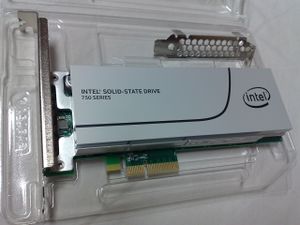
منظمات المعايير
| المنظمة أو اللجنة | اللجنة الفرعية: | الغرض |
|---|---|---|
| INCITS | N/A | Coordinates technical standards activity between ANSI in the USA and joint ISO/IEC committees worldwide |
| T10 | INCITS | SCSI |
| T11 | INCITS | FC |
| T13 | INCITS | ATA |
| JEDEC | N/A | Develops open standards and publications for the microelectronics industry |
| JC-64.8 | JEDEC | Focuses on solid-state drive standards and publications |
| NVMHCI | N/A | Provides standard software and hardware programming interfaces for nonvolatile memory subsystems |
| SATA-IO | N/A | Provides the industry with guidance and support for implementing the SATA specification |
| SFF Committee | N/A | Works on storage industry standards needing attention when not addressed by other standards committees |
| SNIA | N/A | Develops and promotes standards, technologies, and educational services in the management of information |
| SSSI | SNIA | Fosters the growth and success of solid state storage |
التسويق التجاري
التوافر
الجودة والأداء
المبيعات
انظر أيضاً
المصادر
- ^ Whittaker, Zack. "Solid-state disk prices falling, still more costly than hard disks". Between the Lines. ZDNet. Archived from the original on 2 December 2012. Retrieved 14 December 2012.
{{cite web}}: Unknown parameter|deadurl=ignored (|url-status=suggested) (help) - ^ أ ب "Solid State Storage 101: An introduction to Solid State Storage" (PDF). SNIA. January 2009. Archived from the original (PDF) on February 6, 2009. Retrieved 9 August 2010.
- ^ STEC."SSD Power Savings Render Significant Reduction to TCO Archived 2010-11-06 at WebCite." Retrieved October 25, 2010.
- ^ Vamsee Kasavajhala (May 2011). "SSD vs HDD Price and Performance Study, a Dell technical white paper" (PDF). Dell PowerVault Technical Marketing. Archived from the original (PDF) on 12 May 2012. Retrieved 15 June 2012.
{{cite web}}: Unknown parameter|deadurl=ignored (|url-status=suggested) (help) - ^ أ ب "Archived copy". Archived from the original on 2017-03-18. Retrieved 2017-11-05.
{{cite web}}: Unknown parameter|deadurl=ignored (|url-status=suggested) (help)CS1 maint: archived copy as title (link) - ^ "WD shows off its first hybrid drive, the WD Black SSHD". Cnet. Archived from the original on 29 March 2013. Retrieved 26 March 2013.
{{cite web}}: Unknown parameter|deadurl=ignored (|url-status=suggested) (help) - ^ Patrick Schmid and Achim Roos (2012-02-08). "Momentus XT 750 GB Review: A Second-Gen Hybrid Hard Drive". Retrieved 2013-11-07.
- ^ Anand Lal Shimpi (2011-12-13). "Seagate 2nd Generation Momentus XT (750GB) Hybrid HDD Review". Archived from the original on 2013-11-01. Retrieved 2013-11-07.
{{cite web}}: Unknown parameter|deadurl=ignored (|url-status=suggested) (help) - ^ SLC and MLC Archived 2013-04-05 at the Wayback Machine SSD Festplatten. Retrieved 2013-04-10.
- ^ Paul Alcorn. "Huawei Tecal ES3000 PCIe Enterprise SSD Internals". Tom's IT Pro. Archived from the original on 2015-06-19.
{{cite web}}: Unknown parameter|deadurl=ignored (|url-status=suggested) (help) - ^ أ ب "HDD vs. SSD". diffen.com. Archived from the original on 5 December 2014. Retrieved 29 November 2014.
{{cite web}}: Unknown parameter|deadurl=ignored (|url-status=suggested) (help) - ^ "The PC Guide: Spindle Speed". Archived from the original on 2009-07-14.
{{cite web}}: Unknown parameter|deadurl=ignored (|url-status=suggested) (help) - ^ "Super Talent SSD: 16GB of Solid State Goodness". AnandTech. 2007-05-07. Archived from the original on 2009-06-26. Retrieved 2009-10-21.
{{cite web}}: Unknown parameter|deadurl=ignored (|url-status=suggested) (help) - ^ Markoff, John (2008-12-11). "Computing Without a Whirring Drive". The New York Times. p. B9. Archived from the original on 2017-03-12.
Using a standard Macintosh performance measurement utility called Xbench, the Intel solid-state drive increased the computer's overall performance by almost half. Drive performance increased fivefold.
{{cite news}}: Unknown parameter|deadurl=ignored (|url-status=suggested) (help) - ^ "HP Solid State Drives (SSDs) for Workstations".
- ^ أ ب Meyev, Aleksey (2008-04-23). "SSD, i-RAM and Traditional Hard Disk drives". X-bit labs. Archived from the original on 2008-12-18.
{{cite web}}: Unknown parameter|deadurl=ignored (|url-status=suggested) (help) - ^ Rouse, Margaret Rouse. "write amplification". searchsolidstatestorage. Archived from the original on 6 December 2014. Retrieved 29 November 2014.
{{cite web}}: Unknown parameter|deadurl=ignored (|url-status=suggested) (help) - ^ Radding, Alan. "Solid-state storage finds its niche". StorageSearch.com. ACSL. Archived from the original on 2008-01-03. Retrieved 2007-12-29.
{{cite web}}: Unknown parameter|deadurl=ignored (|url-status=suggested) (help) Registration required. - ^ "Hard Drive Data Recovery Glossary". New York Data Recovery. Retrieved 2011-07-14.
- ^ "The Effects of Disk Fragmentation on System Reliability" (PDF). files.diskeeper.com. Archived from the original (PDF) on 5 December 2014. Retrieved 29 November 2014.
{{cite web}}: Unknown parameter|deadurl=ignored (|url-status=suggested) (help) - ^ "Intel High Performance Solid State Drive - Solid State Drive Frequently Asked Questions". Archived from the original on 2010-03-06. Retrieved 2010-03-04.
{{cite web}}: Unknown parameter|deadurl=ignored (|url-status=suggested) (help) - ^ "Windows Defragmenter". TechNet. Microsoft. 2010-04-23. Archived from the original on 2017-08-26.
{{cite web}}: Unknown parameter|deadurl=ignored (|url-status=suggested) (help) - ^ أ ب Hanselman, Scott (3 December 2014). "The real and complete story - Does Windows defragment your SSD?". Scott Hanselman's blog. Microsoft. Archived from the original on 22 December 2014.
{{cite web}}: Unknown parameter|deadurl=ignored (|url-status=suggested) (help) - ^ "How NTFS reserves space for its Master File Table (MFT)". Microsoft. 2008-10-16. Retrieved 2012-05-06.
- ^ "How does a solid state drive work?". Hardware. KnownHost. 27 May 2013. Archived from the original on 18 June 2013. Retrieved 17 June 2013.
{{cite web}}: Unknown parameter|deadurl=ignored (|url-status=suggested) (help) - ^ "Do SSDs heat up?". Tom's Hardware. Retrieved 2012-05-06.
- ^ Meza, Justin; Wu, Qiang; Kumar, Sanjeev; Mutlu, Onur (2015). "A Large-Scale Study of Flash Memory Failures in the Field" (PDF). Archived from the original (PDF) on 2017-08-08.
{{cite journal}}: Cite journal requires|journal=(help); Unknown parameter|deadurl=ignored (|url-status=suggested) (help) - ^ "Intel Solid-State Drive DC P3500 Series" (PDF). Intel. 2015-05-13. Archived from the original (PDF) on 2015-07-01. Retrieved 2015-09-14.
{{cite web}}: Unknown parameter|deadurl=ignored (|url-status=suggested) (help) - ^ "Poorly ventilated system cases can shorten the life of the hard drive". Seagate. Archived from the original on 9 December 2013. Retrieved 2012-05-06.
- ^ "Professional Data Recovery - The Data Rescue Center". The Data Rescue Center. Archived from the original on 2015-11-27.
{{cite web}}: Unknown parameter|deadurl=ignored (|url-status=suggested) (help) - ^ Lonely Planet. "Hard drives at high altitude". Archived from the original on 2016-01-17.
{{cite web}}: Unknown parameter|deadurl=ignored (|url-status=suggested) (help) - ^ "Dot Hill - Solid State Disks (SSDs)". Archived from the original on 2015-09-08.
{{cite web}}: Unknown parameter|deadurl=ignored (|url-status=suggested) (help) - ^ أ ب Kaushik Patowary. "Interesting hard drive facts you probably didn't know - Instant Fundas". Archived from the original on 2015-12-23.
{{cite web}}: Unknown parameter|deadurl=ignored (|url-status=suggested) (help) - ^ "External USB hard drive and risk of internal condensation?". Archived from the original on 2015-09-12.
{{cite web}}: Unknown parameter|deadurl=ignored (|url-status=suggested) (help) - ^ أ ب "SSD vs HDD". SAMSUNG Semiconductor. Archived from the original on 2008-01-06.
{{cite web}}: Unknown parameter|deadurl=ignored (|url-status=suggested) (help) - ^ "Memoright SSDs: The End of Hard drives?". Tom's Hardware. Retrieved 2008-08-05.
- ^ "Simple Installation Guide for Hitachi Deskstar 3.5-inch Hard Disk Drives" (PDF). HGST. May 21, 2004. p. 2. Archived from the original (PDF) on December 21, 2014. Retrieved December 4, 2014.
Hitachi Deskstar drive can be mounted with any side or end vertical or horizontal. Do not mount the drive in a tilted position.
{{cite web}}: Unknown parameter|deadurl=ignored (|url-status=suggested) (help) - ^ Peter Gutmann (2016-03-02). "Secure Deletion of Data from Magnetic and Solid-State Memory". cs.auckland.ac.nz. Archived from the original on 2016-06-06. Retrieved 2016-06-21.
{{cite web}}: Unknown parameter|deadurl=ignored (|url-status=suggested) (help) - ^ "Hard Drive Destruction: Can I erase sensitive data on an old hard drive with Neodymium Magnets?". kjmagnetics.com. Archived from the original on 2016-06-30. Retrieved 2016-06-21.
{{cite web}}: Unknown parameter|deadurl=ignored (|url-status=suggested) (help) - ^ "Myth #42: You can quickly degauss or erase a hard disk drive by sweeping a magnet over it". techarp.com. 2015-12-17. Archived from the original on 2016-07-03. Retrieved 2016-06-21.
{{cite web}}: Unknown parameter|deadurl=ignored (|url-status=suggested) (help) - ^ Lucas Mearian (2008-08-27). "Solid-state disk lackluster for laptops, PCs". Archived from the original on 2008-12-02. Retrieved 2008-09-12.
Corporate-grade SSD uses single-level cell (SLC) NAND memory and multiple channels to increase data throughput and wear-leveling software to ensure data is distributed evenly in the drive rather than wearing out one group of cells over another. And, while some consumer-grade SSD is just now beginning to incorporate the latter features (p. 1). It matters whether the SSD drive uses SLC or MLC memory. SLC generally endures up to 100,000 write cycles or writes per cell, while MLC can endure anywhere from 1,000 to 10,000 writes before it begins to fail, [according to Fujitsu's vice president of business development Joel Hagberg] (p. 4).
{{cite web}}: Unknown parameter|deadurl=ignored (|url-status=suggested) (help) - ^ Kerekes, Zsolt. "SSD Myths and Legends - "write endurance"". StorageSearch.com. ACSL. Archived from the original on 2008-06-25.
{{cite web}}: Unknown parameter|deadurl=ignored (|url-status=suggested) (help) - ^ "No SWAP Partition, Journaling Filesystems, …on an SSD?". Robert.penz.name. 2008-12-07. Archived from the original on 2009-11-02. Retrieved 2009-10-21.
{{cite web}}: Unknown parameter|deadurl=ignored (|url-status=suggested) (help) - ^ "SSDs, Journaling, and noatime/relatime". 2009-03-01. Archived from the original on 2011-08-08. Retrieved 2011-09-27.
{{cite web}}: Unknown parameter|deadurl=ignored (|url-status=suggested) (help) - ^ Tests by Tom's Hardware on the 60 GB Intel 520 SSD calculated a worst-case lifetime of just over five years for incompressible data, and a lifetime of 75 years for compressible data. Ku, Andrew (6 February 2012). "Intel SSD 520 Review: SandForce's Technology: Very Low Write Amplification". Tom's Hardware. Retrieved 10 February 2012.
- ^ Prieur, Marc (16 November 2012). "Components returns rates (7)". BeHardware. Archived from the original on 9 August 2013. Retrieved 25 August 2013.
{{cite web}}: Unknown parameter|deadurl=ignored (|url-status=suggested) (help) - ^ أ ب خطأ استشهاد: وسم
<ref>غير صحيح؛ لا نص تم توفيره للمراجع المسماةbehardware 2011 - ^ Analysis of SSD Reliability during power-outages Archived 2014-01-01 at the Wayback Machine, December 2013
- ^ A study performed by Carnegie Mellon University on manufacturers' published MTBF "Archived copy". Archived from the original on 2013-01-18. Retrieved 2013-02-23.
{{cite web}}: Unknown parameter|deadurl=ignored (|url-status=suggested) (help)CS1 maint: archived copy as title (link) - ^ Ku, Andrew (29 July 2011). "Tom's Hardware, Data center feedback". Tom's Hardware. Retrieved 10 February 2012.
- ^ "SSDs are hot, but not without security risks". IDG Communications. 2010-08-01. Archived from the original on 2010-12-27.
{{cite web}}: Unknown parameter|deadurl=ignored (|url-status=suggested) (help) - ^ https://www.seagate.com/staticfiles/support/docs/warranty/SeagateMediaSanitizationPractices19-Mar-2011.pdf
- ^ "Digital Storage Projections For 2018, Part 1". Forbes Magazine. December 20, 2017.
Flash memory should continue price decreases again starting in 2018, but HDDs should be able to continue to maintain something like a 10X difference in raw capacity prices out into the next decade ...
- ^ أ ب "HDD vs SSD: What Does the Future for Storage Hold? — Part 2". Backblaze, Inc. March 13, 2018.
- ^ Seagate’s new 60TB SSD is world’s largest Archived 2017-04-08 at the Wayback Machine
- ^ [Western Digital Announces Ultrastar He12 12 TB and 14 TB HDDs "Archived copy". Archived from the original on 2017-01-19. Retrieved 2017-01-18.
{{cite web}}: Unknown parameter|deadurl=ignored (|url-status=suggested) (help)CS1 maint: archived copy as title (link)] - ^ "Archived copy" (PDF). Archived from the original (PDF) on 2014-01-23. Retrieved 2014-05-30.
{{cite web}}: Unknown parameter|deadurl=ignored (|url-status=suggested) (help)CS1 maint: archived copy as title (link) - ^ "The SSD Anthology: Understanding SSDs and New Drives from OCZ". AnandTech.com. 2009-03-18. Archived from the original on 2009-03-28.
{{cite web}}: Unknown parameter|deadurl=ignored (|url-status=suggested) (help) - ^ "AnandTech | The SSD Improv: Intel & Indilinx get TRIM, Kingston Brings Intel Down to $115". Anandtech. Archived from the original on 2009-11-08
{{cite journal}}: Cite journal requires|journal=(help); Unknown parameter|deadurl=ignored (|url-status=suggested) (help)CS1 maint: postscript (link) - ^ "Long-term performance analysis of Intel Mainstream SSDs". PC Perspective. 2009-02-13. Archived from the original on 2011-05-02.
{{cite web}}: Unknown parameter|deadurl=ignored (|url-status=suggested) (help) - ^ Schmid, Patrick (2007-11-07). "HyperDrive 4 Redefines Solid State Storage: HyperDrive 4 - The Fastest Hard Disk In The World?". Tom's Hardware.|-
- ^ Prigge, Matt (2010-06-07). "An SSD crash course: What you need to know". InfoWorld. Archived from the original on 2010-06-10. Retrieved 2010-08-29.
{{cite web}}: Unknown parameter|deadurl=ignored (|url-status=suggested) (help) - ^ "eWeek, Toshiba 1.8 drive announcement, January 2011".
قراءات إضافية
- "Solid-state revolution: in-depth on how SSDs really work". Lee Hutchinson. Ars Technica. June 4, 2012.
- Mai Zheng, Joseph Tucek, Feng Qin, Mark Lillibridge, "Understanding the Robustness of SSDs under Power Fault", FAST'13
- Cheng Li, Philip Shilane, Fred Douglis, Hyong Shim, Stephen Smaldone, Grant Wallace, "Nitro: A Capacity-Optimized SSD Cache for Primary Storage", USENIX ATC'14
وصلات خارجية
- خلفية وعامة
- StorageReview.com SSD Guide
- A guide to understanding Solid State Drives
- SSDs versus laptop HDDs and upgrade experiences
- Understanding SSDs and New Drives from OCZ
- Charting the 30 Year Rise of the Solid State Disk Market
- Investigation: Is Your SSD More Reliable Than A Hard Drive? - long term SSD reliability review
- SSD return rates review by manufacturer (2012), hardware.fr - French (English) a 2012 update of a 2010 report based on data from a leading French tech retailer
- Enterprise SSD Form Factor Version 1.0a, SSD Form Factor Work Group, December 12, 2012
- أخرى
- Ted Tso - Aligning filesystems to an SSD's erase block size
- JEDEC Continues SSD Standardization Efforts
- Linux & NVM: File and Storage System Challenges (PDF)
- Linux and SSD Optimization
- Understanding the Robustness of SSDs under Power Fault (USENIX 2013, by Mai Zheng, Joseph Tucek, Feng Qin and Mark Lillibridge)
- SSD vs. m.2, FrugalGaming, by James Heinfield
- CS1 errors: unsupported parameter
- مقالات بأسلوب استشهاد غير متناسق
- CS1 maint: postscript
- Articles with hatnote templates targeting a nonexistent page
- Articles with redirect hatnotes needing review
- Missing redirects
- Articles containing إنگليزية-language text
- Pages using Lang-xx templates
- مقالات بالمعرفة تحتاج تمحيص الحقائق from July 2018
- جميع الصفحات التي تحتاج تمحيص حقائق
- Articles with unsourced statements from February 2017
- Articles with unsourced statements from September 2015
- مقالات فيها عبارات متقادمة منذ 2011
- جميع المقالات التي فيها عبارات متقادمة
- Wikipedia articles in need of updating from September 2015
- All Wikipedia articles in need of updating
- مقالات ذات عبارات بحاجة لمصادر
- أجهزة تخزين الحاسوب
- Non-volatile memory
- خزين الحاسوب الحالة الصلبة
- وسائط تخزين الحاسوب الحالة الصلبة
